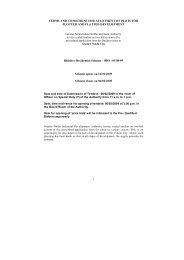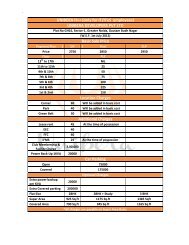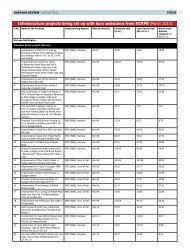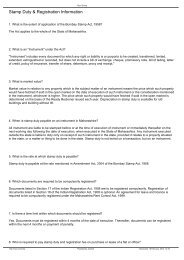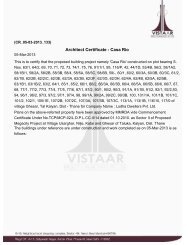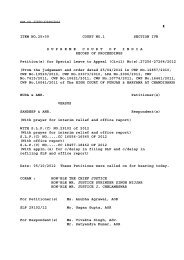JUDGMENT/ORDER IN - WRIT - C No. 37443 of 2011 at <strong>Allahabad</strong> Dated-21.10....http://elegalix.allahabadhighcourt.in/elegalix/WebShow<strong>Judgment</strong>.doPage 144 of 19710/21/2011emergency power under Section 17 with the consequential dispensation of right of hearing under Section 5A ofthe said Act. The <strong>Court</strong>s must examine these questions very carefully when little Indians lose their small propertyin the name of mindless acquisition at the instance of the State. If public purpose can be satisfied by not renderingcommon man homeless and by exploring other avenues of acquisition, the <strong>Court</strong>s, before sanctioning anacquisition, must in exercise of its power of judicial review, focus its attention on the concept of social andeconomic justice.20. While examining these questions of public importance, the <strong>Court</strong>s, especially the <strong>High</strong>er <strong>Court</strong>s, cannot affordto act as mere umpires. In this context we reiterate the principle laid down by this <strong>Court</strong> in Authorised Officer,Thanjavur and another vs. S. Naganatha Ayyar and others reported in (1979) 3 SCC 466, wherein this <strong>Court</strong> held:"1. ......It is true that Judges are constitutional invigilators and statutory interpreters; but they are also responsiveand responsible to Part IV of the Constitution being one of the trinity of the nation's appointed instrumentalities inthe transformation of the socio- economic order. The judiciary, in its sphere, shares the revolutionary purpose ofthe constitutional order, and when called upon to decode social legislation must be animated by a goal-orientedapproach. This is part of the dynamics of statutory interpretation in the developing countries so that courts are notconverted into rescue shelters for those who seek to defeat agrarian justice by cute transactions of manymanifestations now so familiar in the country and illustrated by the several cases under appeal. This caveat hasbecome necessary because the judiciary is not a mere umpire, as some assume, but an activist catalyst in theconstitutional scheme."35.From the various facts disclosed in the said affidavit it appears that the matter was initiated by theGovernment's letter dated 4th of June, 2008 for issuance of Section 4(1) and Section 17 notifications. A meetingfor selection of the suitable site for construction was held on 27th June, 2008, and the proposal for suchacquisition and construction was sent to the Director, Land Acquisition on 2nd of July, 2008. This was in turnforwarded to the State Government by the Director on 22nd of July, 2008. After due consideration of theforwarded proposal and documents, the State Government issued the Section 4 notification, along with Section17 notification on 21st of August, 2008. These notifications were published in local newspapers on 24th ofSeptember, 2008.36. Thereafter, over a period of 9 months, the State Government deposited 10% of compensation payable to thelandowners, along with 10% of acquisition expenses and 70% of cost of acquisition was deposited, and theproposal for issuance of Section 6 declaration was sent to the Director, Land Acquisition on 19th of June, 2009.The Director in turn forwarded all these to the State Government on 17th July, 2009, and the State Governmentfinally issued the Section 6 declaration on 10th of August, 2009. This declaration was published in the local dailieson 17th of August, 2009.37. Thus the time which elapsed between publication of Section 4(1) and Section 17 notifications, and Section 6declaration, in the local newspapers is of 11 months and 23 days, i.e. almost one year. This slow pace at whichthe government machinery had functioned in processing the acquisition, clearly evinces that there was nourgency for acquiring the land so as to warrant invoking Section 17 (4) of the Act.38. In paragraph 15 of the writ petition, it has been clearly stated that there was a time gap of more than 11months between Section 4 and Section 6 notifications, which demonstrates that there was no urgency in the Stateaction which could deny the petitioners their right under Section 5A. In the counter which was filed in this case bythe State before the <strong>High</strong> <strong>Court</strong>, it was not disputed that the time gap between Section 4 notification read withSection 17, and Section 6 notification was about 11 months.39. The construction of jail is certainly in public interest and for such construction land may be acquired. But suchacquisition can be made only by strictly following the mandate of the said Act. In the facts of this case, suchacquisition cannot be made by invoking emergency provisions of Section 17. If so advised, Government caninitiate acquisition proceeding by following the provision of Section 5A of the Act and in accordance with law."The two recent judgments given by the Apex <strong>Court</strong>, both relating to planned industrial development in districtGautam Budh Nagar through Greater NOIDA, are very relevant and need to be referred in some detail.The case of Radhy Shyam (dead) through Lrs. and others vs. State of U.P. and others reported in (2011)5 SCC553, was a case where notification of village Makaura issued on the same date i.e. 12th March, 2008 underSection 4(1) read with Sections 17(1) and 17(4) of the Act were under challenge. The notification issued in theaforesaid case was in the same term as is apparent from the notification quoted in paragraph 2 of the judgment in
JUDGMENT/ORDER IN - WRIT - C No. 37443 of 2011 at <strong>Allahabad</strong> Dated-21.10....http://elegalix.allahabadhighcourt.in/elegalix/WebShow<strong>Judgment</strong>.doPage 145 of 19710/21/2011Radhy Shyam's case (supra). The declaration under Section 6 of the Act was issued thereafter on 19thNovember, 2008. The writ petition was filed in the <strong>High</strong> <strong>Court</strong> challenging the notifications. Specific ground wastaken in the writ petition that respondents without application of mind dispensed with the inquiry on the ground ofurgency. It was also pleaded in the writ petition that acquisition was made with the motive to deprive the ownersfrom their houses in order to fulfil their political obligations and promises to private builders taking shelter ofSection 17. The Apex <strong>Court</strong> issued direction to the respondents to file counter affidavit in the special leavepetition. Along with the affidavit of the relevant documents including the letter dated 15th February, 2008 sent bythe Commissioner and Director, Directorate of Land Acquisition, Revenue Board, U.P. to the State Governmentand the certificate issued by the Collector were brought before the <strong>Court</strong>. The Apex <strong>Court</strong> noted all the relevantfacts, certificates and the ground for justification as was given by the respondents and laid down that there was novalid ground for invoking Section 17(4). The earlier three Judge Bench judgment in Narayan Govind Gavate'scase (supra) was relied. Following was laid down by the Apex <strong>Court</strong> in paragraph 22 of the said judgment:-"22. In cases where the acquisition is made by invoking Section 4 read with Section 17(1) and/or 17(4), the <strong>High</strong><strong>Court</strong> should insist upon filing of reply affidavit by the respondents and production of the relevant records andcarefully scrutinize the same before pronouncing upon legality of the impugned notification/action because anegative result without examining the relevant records to find out whether the competent authority had formed abona fide opinion on the issue of invoking the urgency provision and excluding the application of Section 5-A islikely to make the land owner a landless poor and force him to migrate to the nearby city only to live in a slum. Adeparture from this rule should be made only when land is required to meet really emergent situations like thoseenumerated in Section 17(2). If the acquisition is intended to benefit private person(s) and the provisionscontained in Section 17(1) and/or 17(4) are invoked, then scrutiny of the justification put forward by the Stateshould be more rigorous in cases involving the challenge to the acquisition of land, the pleadings should beliberally construed and relief should not be denied to the petitioner by applying the technical rules of procedureembodied in the Code of Civil Procedure and other procedural laws."At this stage, it is relevant to refer to the materials, which have been referred to in the counter affidavit by the Sateas justification for invocation of Section 17(4) of the Act in the present case as well as scrutiny of original recordsas have been produced by the learned Chief Standing Counsel for perusal of the <strong>Court</strong>. The State in itssupplementary counter affidavit dated 11th September, 2011 filed in Writ Petition No.37443 of 2011 (main writpetition) has brought on the record letter dated 21st July, 2006 which was sent by the Special Officer on Duty,Greater NOIDA to the Additional District Magistrate forwarding proposal for acquisition of 590.289 hectares landof village Patwari. The Note of justification for issuing notification under Section 4/17 of the Act submitted by theGreater NOIDA and counter signed by the Collector as well as Prapatra-10, which has been signed by theCollector have also been enclosed along with the supplementary counter affidavit. Paragraph 3 of thesupplementary counter affidavit notes the Justification given for invoking Section 17(4). Paragraph 3 of theaforesaid supplementary counter affidavit is extracted below:-"3. That, as detailed in paragraph 12(b) of the counter affidavit dated 09.09.2011, a proposal for acquisition of600.600 hectares of land in village Patwari, Pargana and Tehsil Dadari, district Gautam Budh Nagar wassubmitted by Greater Noida Industrial Development Authority vide letter No.266 dated 31.3.2006 to the office ofA.D.M. (L.A.)/OSD, Greater Noida, along with Note of justification for invoking the provisions of Section 17(4) ofthe L.A. Act as the land was needed urgently. The proposal was, thereafter, revised and vide letter No.660 dated21.07.2006, submitted by Greater Noida Industrial Development Authority, it was proposed to acquire an area of590.289 hectares. The urgency for acquiring the land or the purpose of planned industrial development wasreiterated. It was further stated that in absence of acquisition there was possibility of illegal constructions/encroachments over the land proposed for acquisition, and accordingly it was necessary that the urgencyprovisions under section 17 of the L.A. Act may be invoked along with issuance of notification under Section 4(1)of the L.A. Act. True copy of letter dated 21.07.2006 is being filed herewith and marked as Annexure SCA-1 tothis supplementary counter affidavit."The learned Chief Standing Counsel assisted by several Additional Chief Standing Counsel, during course ofhearing, placed the original records of the State Government pertaining to land acquisition proceedings. We haveperused the original records of village Patwari and records of some other village of the State Government. In thesupplementary counter affidavit reference was made to the letter dated 31st March, 2006 of GNOIDA by whichproposal was submitted to the Additional District Magistrate. In the record of the State Government, there isproposal submitted by the Commissioner and Director, Land Acquisition Directorate to the Special Secretarydated 25th February, 2008 along with which the Note of Justification as well as Prapatra as have been filed alongwith the supplementary counter affidavit are also there. A perusal of the original records of the State Governmentreveal following:-





